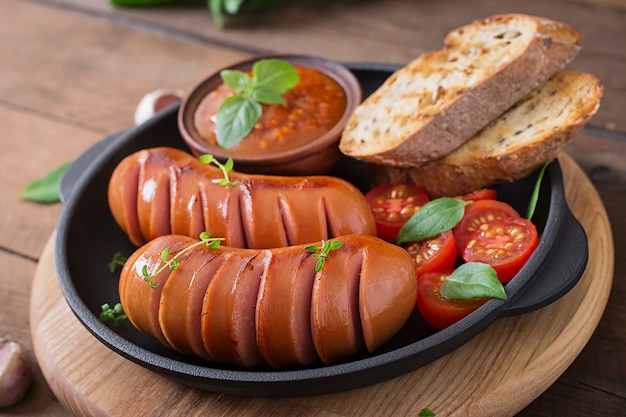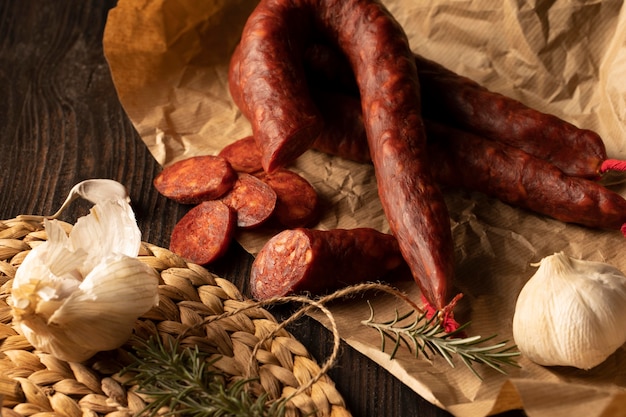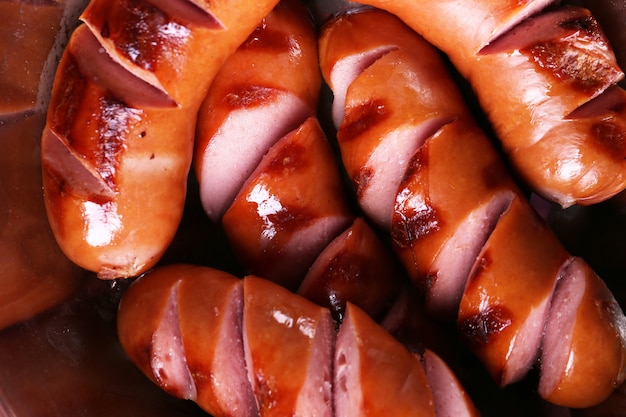Let’s talk chorizo, folks! This vibrant, smoky sausage is a cornerstone of countless delicious dishes, from Spain's iconic paella to hearty, comforting breakfast burritos. But nailing the perfect cook for chorizo can feel a bit like a culinary mystery. I've definitely been there, with my fair share of overcooked, dry chorizo and undercooked, pink chorizo moments. But fret not, my fellow chorizo enthusiasts, because I've finally cracked the code! Through years of experimenting and countless chorizo-fueled meals, I’ve learned the ins and outs of this delicious sausage. Now, I'm ready to share my secrets with you! So grab your apron, pour yourself a glass of something delicious (I’m partial to Spanish red), and let’s dive into the world of chorizo cooking.
(Part 1) Understanding Chorizo: A culinary journey

What is Chorizo? More Than Just a Sausage
First, let’s get acquainted with our star ingredient. Chorizo is a cured, fermented sausage – not raw – typically made from pork, but you can find variations made with beef, chicken, or even lamb. It’s what I call a “flavor bomb,” bursting with a unique blend of smoky, spicy, and savory notes. These powerful flavors stem from the traditional seasoning, which usually includes paprika, garlic, and other spices, but the exact blend varies by region. spanish chorizo, for instance, is known for its fiery heat, while portuguese chorizo tends to be a bit milder. It’s the kind of sausage that truly elevates any dish with its rich, complex character.
Types of Chorizo: A World of Flavors
The world of chorizo is more diverse than you might think! There are two main types you'll encounter:
- Spanish Chorizo: This is the type that most of us are familiar with, and it’s commonly found in supermarkets. It’s usually made with pork, cured with paprika, which gives it that vibrant red color. It packs a punch with its smoky, earthy flavor and noticeable spice.
- Portuguese Chorizo: A bit milder than its Spanish cousin, Portuguese chorizo often blends pork and beef. It has a slightly sweeter flavor profile with hints of garlic and oregano, making it a versatile choice for many dishes.
But that’s not all! There are many other regional varieties like mexican chorizo, which is typically made with ground pork, often has a slightly crumbly texture, and is often found in breakfast burritos. The important thing to remember, no matter the type you choose, is that all chorizo needs to be cooked thoroughly. While chorizo is cured, meaning it's safe to eat without cooking, cooking it brings out its full flavor and texture potential, making for a truly enjoyable experience.
(Part 2) How to Cook Chorizo: Mastering the Basics

Pan-Fried Chorizo: Quick and Easy Deliciousness
This is the most straightforward way to cook chorizo, perfect for those busy weeknights when you crave a quick and tasty meal. Simply grab a non-stick pan, heat it over medium heat, and add your chorizo slices. Cook, stirring occasionally, until the chorizo is nicely browned and cooked through. This usually takes about 5-7 minutes, depending on the thickness of your slices.
Here’s a little secret I’ve learned: a splash of white wine or cider added towards the end of cooking truly elevates the flavor. It deglazes the pan, creating a delicious sauce, and infuses the chorizo with an extra layer of complexity. Just be careful not to let it boil dry! If you're feeling adventurous, adding a few cloves of garlic or a pinch of smoked paprika to the pan can take your chorizo to the next level.
Oven-Baked Chorizo: Hands-Off Cooking at its Best
For a more hands-off approach, the oven is your friend. Preheat it to 350°F (180°C) and line a baking sheet with parchment paper. Place your chorizo slices on the baking sheet, making sure they aren’t overlapping. Bake for 15-20 minutes, or until the chorizo is golden brown and cooked through. This method is fantastic for roasting vegetables, as you can cook the chorizo and vegetables together for a complete and flavorful meal.
Chorizo on the BBQ: Summertime Flavor
Ah, summertime! What’s better than grilling outdoors? Fire up your BBQ, make sure the coals are nice and hot, and place your chorizo directly on the grill. Cook for 5-7 minutes, turning occasionally, until browned and cooked through. This method imparts a beautiful smoky flavor that complements the chorizo perfectly, making it ideal for outdoor gatherings.
(Part 3) Signs of Perfectly Cooked Chorizo: A Visual Guide

Visual Cues: The Color Transformation
One of the first things you’ll notice is a change in color. Raw chorizo has a vibrant red hue, but once it’s cooked, it transforms into a darker, reddish-brown. The chorizo should also look slightly crisped and browned on the outside, with a slightly caramelized edge. If you see any traces of pink inside, it’s not done yet – keep cooking!
Texture: Firm and Springy
The texture of cooked chorizo is key. It should be firm and springy, not soft and mushy. If you press on the chorizo with a fork, it should bounce back slightly. If you're still unsure, break open a piece – it should be firm with no traces of pink or raw meat inside.
Smell: A Symphony of Aromas
And finally, the aroma! Cooked chorizo has a wonderfully fragrant smell that's a delicious mix of smoke, spices, and a slight tanginess. If the chorizo smells faintly sour or ammonia-like, it may be off, and you should discard it.
(Part 4) cooking time: Factors to Consider
Variable Cooking Times: A Matter of Details
The time it takes to cook chorizo can vary depending on a few key factors:
- Type of chorizo: Spanish chorizo, being thinner, tends to cook faster than Portuguese chorizo.
- Thickness of the chorizo: Thin slices will cook faster than thick slices, so keep an eye on them.
- Cooking method: Chorizo cooked on the BBQ or in the oven will take longer than chorizo cooked in a pan.
- Amount of chorizo: Cooking a large batch of chorizo will take longer than cooking a small amount, so adjust your cooking time accordingly.
Checking for Doneness: Ensuring food safety
It’s always a good idea to err on the side of caution and make sure your chorizo is cooked through. You can check for doneness by breaking open a piece and making sure there are no traces of pink. You can also use a meat thermometer, but be aware that the temperature for cooked chorizo varies depending on the type. For Spanish chorizo, the internal temperature should be at least 155°F (68°C), while for Portuguese chorizo, it should be at least 160°F (71°C).
(Part 5) Chorizo in Dishes: Elevating Flavors
Chorizo in Paella: A Spanish Classic
Paella, the iconic Spanish rice dish, is simply incomplete without chorizo. The rich, smoky flavor of the sausage adds a magnificent depth to the dish, complementing the saffron and seafood perfectly. In a traditional paella, the chorizo is usually added towards the end of cooking, giving it a chance to crisp up and release its flavor. I love to add a touch of paprika to my paella for an extra kick of flavor.
Chorizo in Breakfast Burritos: A Flavorful Start
When it comes to breakfast burritos, chorizo is a game-changer. The spicy, savory sausage perfectly complements the other ingredients like eggs, cheese, and salsa. I like to cook my chorizo in a pan until it’s crispy, then crumble it into my burritos. The crispy chorizo adds a delightful crunch and extra flavor, making every bite a delicious experience.
Chorizo in pasta dishes: A Flavorful Twist
Don’t underestimate the power of chorizo in pasta dishes! Adding chorizo to your favorite pasta sauce can elevate it to a whole new level. I love to use chorizo in a simple tomato sauce, along with a few cloves of garlic and a sprinkle of oregano. The chorizo adds a smoky depth to the sauce that complements the pasta perfectly, turning a simple dish into something truly special.
Chorizo in Soups and Stews: Hearty and Comforting
Chorizo can also add a touch of richness and flavor to soups and stews. For example, a simple chorizo and bean soup is a hearty and comforting meal that’s perfect for a chilly evening. The chorizo adds a depth of flavour that complements the beans and vegetables perfectly, making it a satisfying and flavorful dish.
(Part 6) Beyond the Basics: Creative chorizo recipes
Chorizo and Chickpea Stew: Vegetarian Delight
For a flavor-packed vegetarian dish, try this chorizo and chickpea stew. Simply cook the chorizo in a pot until browned, then add chopped onions, garlic, and a can of diced tomatoes. Add chickpeas, vegetable broth, and a pinch of smoked paprika and simmer until the chickpeas are tender. Serve with crusty bread for dipping and enjoy this hearty and flavorful stew.
chorizo and potato hash: A Twist on Tradition
A twist on the classic breakfast hash, chorizo and potato hash is a hearty and satisfying meal. Cook diced chorizo in a pan until crispy, then add diced potatoes, onions, and peppers. Season with salt, pepper, and a dash of paprika and cook until the potatoes are tender and golden brown. Serve with a fried egg for a complete meal that’s both delicious and satisfying.
Chorizo stuffed peppers: Colorful and Flavorful
For a colorful and flavorful dish, try these chorizo stuffed peppers. Hollow out bell peppers and fill them with a mixture of cooked chorizo, rice, onions, and peppers. Bake until the peppers are tender and the filling is heated through. Serve with a dollop of sour cream or yogurt for a creamy touch and enjoy this vibrant and flavorful meal.
(Part 7) Storing Chorizo: Keeping it Fresh and Flavorful
Storing Fresh Chorizo: Maximizing Freshness
If you buy fresh chorizo, store it in the fridge for up to 3 days. To keep it fresh, wrap it tightly in plastic wrap or place it in an airtight container. You can also freeze fresh chorizo for up to 3 months. To freeze, simply wrap the chorizo tightly in plastic wrap and then place it in a freezer bag. Make sure to label it with the date.
Storing Dried Chorizo: A Longer Shelf Life
Dried chorizo can be stored at room temperature for up to 3 months. Just keep it in an airtight container in a cool, dry place. You can also freeze dried chorizo for up to 6 months. To freeze, simply wrap it tightly in plastic wrap and then place it in a freezer bag.
(Part 8) FAQs: Your Chorizo Questions Answered
1. Can I Cook Chorizo From Frozen?
Yes, you can! It just takes a little longer. Simply thaw the chorizo in the fridge overnight, or defrost it in the microwave. Then, cook it according to your preferred method. If you're cooking it in a pan, be sure to add some extra cooking time, as it will take a little longer to reach the desired temperature.
2. What Happens If I Overcook Chorizo?
Overcooked chorizo will become dry and tough, losing its juicy texture. It's best to cook it to a point where it's browned and cooked through, but still slightly soft in the centre. If you do overcook it, there's not much you can do to remedy it, unfortunately. However, you can try to salvage it by adding it to a sauce or stew, where the extra cooking time won't be as noticeable.
3. Can I Eat Chorizo Raw?
It's important to note that chorizo is cured, not raw. This means that it's safe to eat without cooking, but you won't get the best flavor and texture from it. Always cook chorizo thoroughly for the best results. However, it's okay to eat chorizo raw if you're comfortable with the risk. Just make sure to buy it from a reputable source and check that it’s stored properly. Keep in mind that some people may be more sensitive to eating raw or undercooked meat than others.
4. Can I Use Chorizo in Place of Other Sausages?
You can use chorizo as a substitute for other sausages, but keep in mind that it will have a different flavor profile. If you’re using chorizo in place of a milder sausage, you might want to adjust the spices in your recipe accordingly. For example, if you're using chorizo in a breakfast sausage recipe, you might want to reduce the amount of paprika or chili powder. Chorizo can bring a lovely richness to dishes that other sausages can't quite replicate.
5. Can I Use Chorizo in a Vegetarian or Vegan Dish?
While chorizo is traditionally made with pork, there are now many vegan and vegetarian chorizo options available. These are typically made with plant-based protein sources like soy protein, seitan, or lentils, and they’re often flavoured with spices and herbs to mimic the flavour of traditional chorizo. These are a great way to add a smoky and spicy kick to your vegetarian dishes.
There you have it! With these tips and tricks, you'll be a chorizo cooking master in no time. So go forth and experiment, and let your chorizo adventures begin! Happy cooking!
Everyone is watching

Corn on the Cob: The Ultimate Guide to Perfectly Cooked Ears
Healthy MealsAh, corn on the cob. Just the name evokes images of sunny days, barbecues, and that sweet, juicy flavour that ...

Perfect Pork Roast Oven Cooking Time: A Guide to Delicious Results
Healthy MealsThere's something truly satisfying about a perfectly roasted pork. The aroma alone is enough to make your mout...

Ham Cooking Time: How Long to Bake, Smoke, or Boil a Delicious Ham
Healthy MealsAh, ham. It's a classic, isn't it? A real crowd-pleaser, especially around holidays. And when done right, it'...

Scallops: The Ultimate Guide to Perfect Cooking
Healthy MealsAh, scallops. Those delicate, sweet, and utterly delicious morsels of the sea. They hold a special place in my...

Spaghetti Squash: The Ultimate Guide to Cooking and Serving
Healthy MealsRemember that time you saw spaghetti squash at the supermarket, looking all bumpy and strange, and thought, "W...
